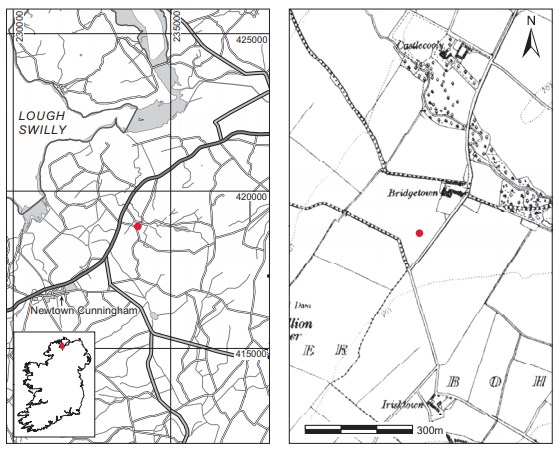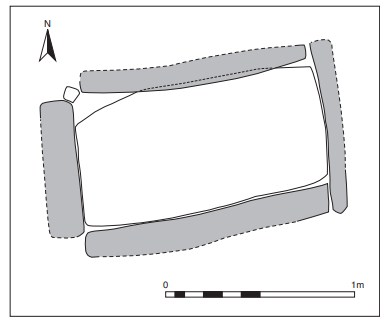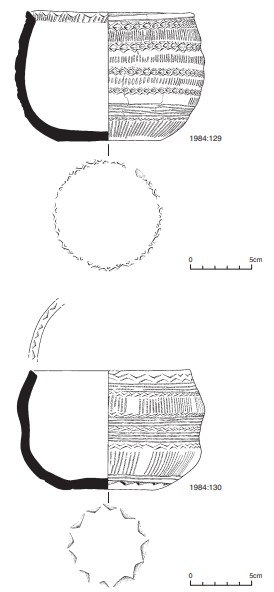County: Donegal Site name: BOHULLION UPPER, CO. DONEGAL
Sites and Monuments Record No.: SMR DG047-021SMR DG047-018 Licence number: E1047
Author: MARY CAHILL
Site type: Early Bronze Age graves
Period/Dating: —
ITM: E 633906m, N 918872m
Latitude, Longitude (decimal degrees): 55.016254, -7.469845
Introduction
In September 1984 a short cist containing a cremation and two bowls was discovered near Newtown Cunningham, Inishowen, Co. Donegal. The presence of a large stone (the capstone) had been known for many years at the spot, and the cist underneath was finally discovered by Mr Noel Buchanan while ploughing. Mr Buchanan removed the two bowls from the cist and the Garda Síochána at Newtown Cunningham were informed. During the course of a Garda inspection of the site the contents of the cist were considerably disturbed in an effort to locate a skeleton. The NMI was informed by the Gardaí, and the site was investigated by Mary Cahill on 21 September of that year.

Location (Fig. 3.26)
The site was in the townland of Bohullion Upper, north-east Co. Donegal.45 The cist was approximately 3.5km north-east of Newtown Cunningham, on a slight elevation between c. 30m and 60m above sea level. No similar sites are known from that townland, but an early Bronze Age pit burial containing a cordoned urn and a cremation was discovered in Gortlush townland, just 1.5km south-east of the Bohullion Upper site.46
Description of site
The cist was subrectangular in plan, with its long axis aligned east/west (Fig. 3.27). Internally it measured 1.27m long by 0.8m wide by 0.51m high. It was formed of large flat stones, a single edge-set slab at the northern, southern and eastern sides, while that at the west was formed of four slabs placed flat one on top of the other.

The floor of the cist was paved with a single rectangular slab. The cist was originally covered by a capstone, but this had been removed prior to the investigation. The cist stones were identified by Dr John Jackson as a type of mica schist probably from the Inishowen area.
The cist contained the cremated remains of a young adult of unknown sex and a juvenile, accompanied by a ribbed and a constricted bowl. Both of the bowls were removed from the cist by the finder but had apparently been found upright, each containing a quantity of soil. The ribbed bowl was allegedly placed in the centre of the western end of the cist, while the bipartite bowl had been found in the centre of the eastern end. The fill of the cist, which contained the cremation (1984:131), had been removed by the Gardaí in order to ascertain whether or not a skeleton was present. Much of the cremation was therefore not recovered. A considerable quantity of soil had fallen into the cist over the years, but it was impossible to know the depth of the original fill owing to disturbance. Most of the surviving bone was recovered from the western end of the cist, apparently scattered over the paving flag, and some was found lodged between the edges of the floor slab and the side stones. Less bone was recovered from the eastern end but it seemed to have suffered even more disturbance than the western end.
Pottery
Ribbed bowl, 1984:129 (Fig. 3.28)
The vessel is in very good condition. The rim is uneven and the body slightly lopsided. The body of the vessel is decorated all over and has a plain base. It is damaged on one side in two places where the outer skin of clay has separated from the inner core. Some grits and mica flecks are visible in the fine, orange-coloured clay body.
The bevel is decorated by a series of short, slanted, comb-impressed lines. Below this line the decorative motifs consist of alternating rows of divided lozenges and panels of vertical comb-impressed lines. The lozenges are executed in false relief in four rows bordering and alternating with the three panels of vertical lines which also form the ribs of the vessel.

Next is a panel consisting of five comb-impressed horizontal lines followed by a continuous zigzag line; another panel of vertical lines follows the vessel as it curves underneath, and finally another zigzag line completes the decorative scheme.
Dimensions: max. H 11cm; max. int. depth 9.7cm; ext. D rim 13.57cm; D of base 8.5cm; W of rim bevel 1.1cm.
Constricted bowl, 1984:130 (Fig. 3.28)
The vessel is in very good condition. The rim is damaged slightly at one point, showing that the clay body had not completely oxidised. The vessel is made from a very fine orange/buff ware and is well fired. Some grits are visible and tiny mica flecks can be seen. The rim has an internal decorated bevel. The vessel is decorated all over and the base is also decorated. The comb impressions have a very sharp, fresh appearance.
The rim bevel is decorated with unjoined triangular impressions varying in size. The decoration on the vessel is arranged in concentric bands. The first band below the rim consists of a continuous chevron in false relief produced by a triangular tool with a toothed edge on one side only. Next is a band of four lines of continuous horizontal comb impressions, followed by a band of narrow, plain, continuous chevrons. The next zone consists of nine panels of varying width composed of narrow, vertical comb-impressed lines alternating with narrow plain bands. The next panel covers the constriction of the vessel and consists of a continuous small chevron line, four lines of horizontal comb impressions, a chevron line and another four horizontal lines, bordered by a chevron. Below this is another, larger band of vertical panels of comb-impressed lines alternating with plain panels. This is bordered by a series of three concentric plain lines in false relief somewhat imperfectly executed. Immediately outside this panel is a row of large triangular impressions. The base of the vessel is slightly concave and is decorated by another row of triangular impressions, giving the effect of a star pattern. The area between the two rows of triangular impressions is plain, as is the base proper.
Dimensions: max. H 9.75cm; max. depth 8.8cm; ext. D rim 13.22cm; D base 7.2cm; W rim 0.8cm.
Comment
A radiocarbon date of 3680±50 BP,47 which calibrates at 95% probability to 2210–1920 BC, was produced from carbonate (Brindley 2007, 57). Brindley (2007, 172–3) places the bowls from Bohullion in stage 1 of the development of the bowl tradition, which is characterised by simple linear elements arranged in bands and dated to 2160–2080 BC.
HUMAN REMAINS
BARRA Ó DONNABHÁIN
Introduction
A small sample (169.6g; 217 fragments) of cremated human bone (1984:131) was submitted for examination. As the site had been disturbed after discovery and prior to excavation, it is likely that the original deposit was somewhat larger. Despite this disturbance, it is possible to determine that this small collection of well-incinerated bone contains the remains of an adult of unknown sex and a juvenile. The average fragment size is between 20mm and 30mm.
Adult
The adult remains consist mostly of portions of the cranium and thorax, with relatively few long bone fragments. The observable sutures among the cranial fragments suggest that this was a younger adult—probably less than 35 years at the time of death. Despite the presence of fragments of the nuchal crest and the left mastoid process, it was not possible to determine the sex of this person.
The only pathological change noted was the presence of a Schmorl’s node on the inferior surface of one of the two thoracic centra recovered. This lesion is caused by the herniation of the gelatinous core of the intervertebral disc. This is usually the result of the subjection of the disc to severe strain, especially by compression forces from carrying heavy loads. This lesion often occurs in association with evidence for degenerative joint disease and is not unusual among early population groups.
Juvenile
Only nine fragments of a juvenile skeleton were identified. Five of these were cranial, three were probably from the ribs and one was a fragment of an unidentified long bone. In this case an age estimate can only be based on the general size of the remains. Using this criterion alone, an age at death of about five years seems most likely.
Conclusions
The remains are those of a younger adult of unknown sex and a juvenile probably aged about five years. All of the fragments are fully calcined and the burning patterns indicate an efficient cremation process. The deliberate crushing of the bones may also have been part of the ritual process.
45. Parish of Burt, barony of Inishowen. SMR DG047-021——. IGR 233962 418885.
46. SMR DG047-018——.
47. GrA-14641.